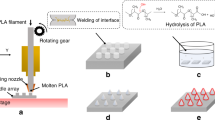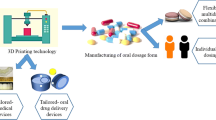Abstract
Localized delivery of drugs or nanoparticles for oral cancer is always preferred. Additive manufacturing (AM)-driven 3D-printed wafers to deliver nanoparticles offers a new dimension to the cutting-edge delivery perspective. Nanostructured lipid carriers (NLCs) were loaded inside 3D wafers, printed using poly (vinyl alcohol) as polymer. Wafers showed a loading capacity of 50 ± 2.5 mg with desired surface and unaltered thermal properties. In vitro release of NLCs was performed to ascertain the release of particles from 3D wafer. Derived Kilo Counts per Second (KCPS) obtained from dynamic light scattering (DLS) corresponds to NLCs population. The progressive release of NLCs from 3D wafer was observed in a time-dependent manner as the PVA matrix became exhausted and started dissolving in artificial saliva, leading to the release of complete NLCs. Thus, NLCs delivery through 3D wafers at the desired site of action can be considered the latest AM-driven treatment approach for oral cancer.
Graphic abstract










Similar content being viewed by others
Data availability
The authors confirm that the data supporting the key findings can be made available upon request to the corresponding author.
References
A. Goyanes, U. Det-Amornrat, J. Wang, A.W. Basit, S. Gaisford, 3D scanning and 3D printing as innovative technologies for fabricating personalized topical drug delivery systems. J. Control. Release 234, 41 (2016)
C.L. Ventola, Medical applications for 3D printing: current and projected uses. Pharm. Ther. 39(10), 704 (2014)
U. Bhatt, T.K. Malakar, U.S. Murty, S. Banerjee: 3D printing of immediate-release tablets containing olanzapine by filaments extrusion. Drug Dev. Indust. Pharm. (2021). https://doi.org/10.1080/03639045.2021.1879833
A. Al-Taie, J. Pan, P. Polak, M.R. Barer, X. Han, A.P. Abbott, Mechanical properties of 3-D printed polyvinyl alcohol matrix for detection of respiratory pathogens. J. Mech. Behav. Biomed. Mater. 112, 104066 (2020)
A. Goyanes, P.R. Martinez, A. Buanz, A.W. Basit, S. Gaisford, Effect of geometry on drug release from 3D printed tablets. Int. J. Pharm. 494(2), 657 (2015)
A. Maroni, A. Melocchi, F. Parietti, A. Foppoli, L. Zema, A. Gazzaniga, 3D printed multi-compartment capsular devices for two-pulse oral drug delivery. J. Control. Release 268, 10–18 (2017)
G. Matijašića, M. Gretić, J. Vinčić, A. Poropat, L. Cuculić, T. Rahelić, Design and 3D printing of multi-compartmental PVA capsules for drug delivery. J. Drug Deliv. Sci. Technol. 52, 677–686 (2019)
T.K. Malakar, V.S. Chaudhari, S.K. Dwivedy, U.S.N. Murty, S. Banerjee, 3D printed housing devices for segregated compartmental delivery of oral fixed dose anti-tubercular drugs adopting print & fill strategy. 3D Print. Addit. Manuf. (2021). https://doi.org/10.1089/3dp.2021.0037
V.S. Chaudhari, U.S. Murty, S. Banerjee, Lipidic nanomaterials to deliver natural compounds against cancer: a review. Environ. Chem. Lett. 18, 1803–1812 (2020). https://doi.org/10.1007/s10311-020-01042-5
V.S. Chaudhari, P.K. Hazam, S. Banerjee, Lipid nanoarchitectonics for natural products delivery in cancer therapy, in Sustainable Agriculture Reviews, vol. 44 (Springer, Cham, 2020), pp. 169–203. https://doi.org/10.1007/978-3-030-41842-7_5
V.S. Chaudhari, U.S. Murty and S. Banerjee: Nanostructured Lipid Carriers as a strategy for encapsulation of active plant constituents: Formulation and in vitro physicochemical characterizations. Chem. Phys. Lipids. 235, 105037 (2021)
R. Beck, P. Chaves, A. Goyanes, B. Vukosavljevic, A. Buanz, M. Windbergs, A. Basit, S. Gaisford, 3D printed tablets loaded with polymeric nanocapsules: an innovative approach to produce customized drug delivery systems. Int. J. Pharm. 528(1–2), 268 (2017)
J. Smeraldi, R. Ganesh, J. Safarik, D. Rosso, Statistical evaluation of photon count rate data for nanoscale particle measurement in wastewaters. J. Environ. Monit. 14(1), 79 (2012)
J. Norman, R.D. Madurawe, C.M. Moore, M.A. Khan, A. Khairuzzaman, A new chapter in pharmaceutical manufacturing: 3D-printed drug products. Adv. Drug Deliv. Rev. 108, 39 (2017)
A. Goyanes, J. Wang, A. Buanz, R. Martínez-Pacheco, R. Telford, S. Gaisford, A.W. Basit, 3D printing of medicines: engineering novel oral devices with unique design and drug release characteristics. Mol. Pharm. 12(11), 4077 (2015)
V.S. Chaudhari, T.K. Malakar, U.S. Murty, S. Banerjee: 3D Printed Mouth Dissolving Wafers: Application No. 342624–001. Cbr No. 202856, FER Issued: 27 May, 2021, Date of Filing: 22 April, (2021)
V.S. Chaudhari, T.K. Malakar, U.S. Murty, S. Banerjee, Extruded filaments derived 3D printed medicated skin patch to mitigate destructive pulmonary tuberculosis: design to delivery. Expert Opin. Drug Deliv. 18(2), 301–313 (2021). https://doi.org/10.1080/17425247.2021.1845648
J.H. Miller, T. Danielson, Y.B. Pithawalla, A.P. Brown, C. Wilkinson, K. Wagner, F. Aldeek, Method development and validation of dissolution testing for nicotine release from smokeless tobacco products using flow-through cell apparatus and UPLC-PDA. J. Chromatogr. B 1141, 122012 (2020)
Acknowledgments
The authors would like to acknowledge the National Mission on Himalayan Studies (NMHS) [File No: GBPI/NMHS-2017-18/HSF-02], Ministry of Environment, Forest and Climate Change, Govt. of India to provide the necessary funding support for this research. Authors are also thankful to the Department of Pharmaceuticals, Ministry of Chemicals and Fertilizers, Govt. of India.
Author information
Authors and Affiliations
Corresponding author
Ethics declarations
Conflict of interest
The authors declare that there are no conflicts of interest.
Rights and permissions
About this article
Cite this article
Chaudhari, V.S., Malakar, T.K., Murty, U.S. et al. Fused deposition modeling (FDM)-mediated 3D-printed mouth-dissolving wafers loaded with nanostructured lipid carriers (NLCs) for in vitro release. Journal of Materials Research 36, 3963–3973 (2021). https://doi.org/10.1557/s43578-021-00288-1
Received:
Accepted:
Published:
Issue Date:
DOI: https://doi.org/10.1557/s43578-021-00288-1




